Mark Sisson's Blog, page 69
July 1, 2020
Epigenetics, or What I Mean by “Reprogram Your Genes”
 You can’t change your genes. But you can program them.
You can’t change your genes. But you can program them.
The modern world presents a number of problems for our genes. The world we’ve constructed over the last 50 years is not the environment in which our genetic code evolved. Our genes don’t “expect” historically low magnesium levels in soil, spending all day indoors and all night staring into bright blue lights, earning your keep by sitting on your ass, getting your food delivered to your door, communicating with people primarily through strange scratchings that travel through the air. So when these novel environmental stimuli interact with our genetic code, we get disease and dysfunction.
The genes look bad viewed through a modern prism. They get “associated” with certain devastating health conditions. But really, if you were to restore the dietary, behavioral, and ambient environments under which those genes evolved, those genes wouldn’t look so bad anymore. They might even look great.
This is epigenetics: altering the programming language of your genes without altering the genes themselves.
Think of your genome as computer hardware. If you were to program your computer you wouldn’t be changing the hardware; you would be changing the software that tells the computer what to do. So just as we talk about reprogramming or programming a computer and don’t suggest that the hardware itself has changed we likewise can talk about reprogramming our genes without suggesting that the genes have changed.
Okay, so how does this play out in reality? Are there any good examples of epigenetics in humans?
One of the most striking cases of the environment altering gene expression was in an old study of a homogeneous population of Berbers from North Africa.1 Researchers studied desert nomads, mountain agrarians, and coastal urban residents. All were Berbers with low genetic variance. These people had very similar genetic patterns—were from the same basic genetic stock—but very different living situations.
The researchers analyzed the white blood cells of the group “to study the impact of the transition from traditional to urbanized lifestyles on the human immune system.” Berbers from urban environments had evidence of upregulated respiratory and immune genes, for example. Those same genes lay more “dormant” in nomadic and agrarian Berbers.
Overall, gene expression between the three groups varied by up to one-third based on geographic location and corresponding lifestyle. In their conclusion, the authors lay out the foundation of everything we talk about on this blog and in this space:
“Diseases due to genetic factors in urban populations may bear little resemblance to the impact of the same genetic factors in traditional societies.”
Did you get that?
“Bad genes” aren’t bad in traditional environments. The trick, of course, is figuring out what makes up the traditional environment and whether you can replicate it in the modern world.
Let’s look at a specific example: Tobacco.
Epigenetic Effects of Tobacco
Tobacco smoking “silences” the MTHFR gene via hypermethylation.2 Since MTHFR is the gene that constructs the proteins we use to activate thousands of other genes, suppressing MTHFR suppresses all those genes that rely on MTHFR-related proteins for activation. This disrupts numerous physiological systems and can set the stage for things like birth defects, cancer, and heart disease. It’s an epigenetic disaster, and it’s one reason why smoking increases the risk of so many different diseases.
Tobacco also induces hypermethylation (overactivation) of the GCLC gene which controls glutathione production. This causes a suppression of glutathione levels, an increase in oxidative stress, and initiation of COPD (chronic obstructive pulmonary disease).3 GCLC is meant to deal with more moderate levels of toxins and irritants; these can actually have a beneficial hormetic effect that triggers higher levels of glutathione and less oxidative stress. In this case, tobacco represents a supranormal stimulus that turns a helpful gene harmful.
Or how about the genetics of obesity?
Epigenetics and Obesity
For the last decade, we’ve been inundated with the idea that obesity is caused by your genes. That some people are just destined to be be overweight. Sure enough, there are dozens of genes linked to an elevated risk of obesity and overweight.
Only genes can’t wholly explain the huge rise in obesity rates over the last hundred years because genes don’t change that fast. People used to be thin, and now they aren’t, and they have the same basic genetic profiles.
The real problem is that almost everyone in the western world exists in a shared food environment which is obesogenic. If you live in America, you’re awash in drive-thrus, Big Gulps, and inexpensive, delicious processed food that’s been engineered to interact with the pleasure centers in your brain. Most modern countries are in similar boats, and obesity rates are climbing across other nations as they adopt our food-ways and work habits. The genes aren’t changing (at least, not quick enough to account for the stats), the environment is changing.
Because the environment has changed for everyone, and most people never really question its obesogenic nature — they eat the pizza, they buy the processed food, they sit for eight hours a day at work and watch TV for four, they slog away on the treadmill—researchers looking for the genetic origins of obesity miss or discount the effect of environment. Almost everyone whose genetic data they’re examining is exposed to the same obesogenic food environment, and its ubiquity masks its effects. And because some people appear to have genetic profiles that protect them against obesity, researchers lay the blame at the feet of the genes.
The “epigenetics of obesity” is more accurate than the “genetics of obesity.”
Let’s see a few more examples.
Exercise Non-responders Epigenetics
Some people carry an “exercise non-responder” gene. by most counts, it’s 15% of the population. For these folks, doing standard “cardio” doesn’t do much. It may even impair insulin sensitivity, raise blood pressure, lower HDL, and leave cardiovascular fitness unchanged.4
If the idea of someone being an exercise “non-responder” sounds ridiculous and unbelievable, you’re right. It turns out that while regular cardio is neutral or even detrimental to this genetic profile, high-intensity training confers the normal benefits you’d expect from exercise5. I’d also guess that resistance training would work as well.
It’s not the genes that are faulty. It’s the (exercise) environment that’s faulty.
MTHFR Mutation Epigenetics
MTHFR mutations often impair folate absorption or conversion of folic acid into bioavailable folate, and they increase the requirements of others nutrients like choline and vitamin B12. In the modern food environment bereft of vegetation and nutrient-dense animal products, those mutations cause huge issues. In a traditional food environment full of vegetation and nutrient-dense animal products, or supplemental forms that mimic the active food forms, they aren’t as bad.
If you eat a lot of vegetables (a good source of folate), you weaken the link between MTHFR mutations and kidney cancer.6
If you have some of the common MTHFR mutations, you need to eat more dietary choline (eggs, liver).7 Doing so preserves methylation status.8
PUFA Metabolism Epigenetics
Your genes also affect fat metabolism. Some mutations in the FADS1 improve the ability of a person to elongate plant omega-3s into long-chained omega-3s like the fish fats EPA and DHA. In the context of a low-fish diet, they can still make the EPA and DHA they require to function as long as they eat some alpha-linolenic acid. This mutation is more common in populations with a long history of farming.
Another mutation impairs the ability of a person to elongate those plant fats into animal-type EPA and DHA; they need to eat a high-fish diet or supplement with fish oil to get the omega-3s their bodies need. That’s the boat I’m in—I fucntion best with a steady supply of long-chained omega-3s in my diet, probably because my recent ancestors ate a lot of seafood. This mutation is more common in populations with a shorter history of farming, or a longer history of reliance on seafood.
What’s the point of all this?
There are multiple future possible versions of you. It’s up to you to decide which version you will become. It’s up to you to make lifestyle choices that direct genes toward fat burning, muscle building, longevity and wellness, and away from fat storing, muscle wasting, disease and illness. The day-to-day choices we make—whether it’s what to pack for lunch, or hitting the snooze button and missing the gym, or even sneaking a cigarette break—don’t just impact us in the short-term (or even in ways that are immediately clear to us). That can make this scary, but it can also be empowering.
You can fix yourself. You can be better. Your genes can work better. Everyone, no matter how dire their circumstances or how “poor” the cards they were dealt were, can forge their own epigenetic destiny.
You can’t ignore the genes. They still matter. You have to figure out, of course, how your particular genes interact with diet, exercise, sleep, sun, nature, socializing, and every other lifestyle behavior. That’s the journey you’re on. That’s the journey we’re all on—it’s what this website and movement are about.
There’s a lot we don’t know about this topic. What if I don’t have a study I can refer to? What if I don’t sign up for a DNA analysis—am I out of luck?
Use your intuition when you don’t have a study or haven’t defined an epigenetic mechanism: Does it feel right? Does it feel wrong? Are you getting good results? How’s your energy? How’s your performance? Those subtle (or not-so-subtle) cues from our subconscious and direct feedback from our waking life are where true knowledge and wisdom lie. After all, your genes “want” you to do the right thing. If we’re cued into our subconscious and we’ve led a generally healthy way of life, we become more sensitive to those messages. Those flutters of doubt or little urges we get are the body’s way of telling us we’re headed for epigenetic ruin or success.
Listen to those, or at least consider and don’t ignore them.
This is what The Primal Blueprint, The Keto Reset Diet, The Primal Connection, and even Primal Endurance have all been about. It’s why the sub-title of my first book is “Reprogram Your Genes for Effortless Weight Loss, Vibrant Health and Boundless Energy”. And it’s what we talk about (either directly or indirectly) day-in and day-out here at Mark’s Daily Apple.
Now I’d love to hear from you. Do you have any questions about epigenetics? About how we can alter our genetic destiny through modifying our environments?
Leave them down below.
References https://journals.plos.org/plosgenetics/article?id=10.1371/journal.pgen.1000052https://www.eurekalert.org/pub_releases/2008-12/aafc-ilc122308.phphttps://pubmed.ncbi.nlm.nih.gov/26087411/https://www.ncbi.nlm.nih.gov/pubmed/22666405https://www.theglobeandmail.com/life/health-and-fitness/fitness/non-responders-need-to-try-harder-when-exercising-study-suggests/article27513859/https://pubmed.ncbi.nlm.nih.gov/18098291/https://pubmed.ncbi.nlm.nih.gov/27342765/https://pubmed.ncbi.nlm.nih.gov/20220206/
The post Epigenetics, or What I Mean by “Reprogram Your Genes” appeared first on Mark's Daily Apple.



June 30, 2020
Measuring Ketones: What, When, Why, and How
 Keto is unique compared to other diets because there is an objective marker that tells you if you’re on the right track. With an easy at-home test, you can confirm that you are, in fact, in a state of ketosis.
Keto is unique compared to other diets because there is an objective marker that tells you if you’re on the right track. With an easy at-home test, you can confirm that you are, in fact, in a state of ketosis.
Regular readers probably know I’m not a big data tracker. My energy, sleep, workout performance, stamina, and enjoyment of life tell me almost everything I need to know about how well I’m doing. Nevertheless, I get that some people love to play the self-quantification game. In some medical situations, measuring ketones is advisable, even necessary, as well. I’m not a total curmudgeon about it. Heck, I’ve been known to check in on my blood glucose and ketones from time to time.
If you’re thinking about testing, you should become familiar with the three different methods. Each has its own pros and cons. You’ll want to pick the option that’s right for you.
Stay on track no matter where you are! Instantly download your Primal and Keto Guide to Eating Out
What Exactly Are You Measuring?
Let’s back up and do a quick refresher on ketogenic diets. These are any diets where carbohydrate intake is restricted below about 50 grams of total carbs per day. When you restrict carbs, you are really restricting how much glucose the body has to meet its energy needs. Without much glucose coming in, the body needs an alternative fuel source, especially for the brain, which doesn’t run well on fat. That fuel source is ketones.
The liver produces ketones from fatty acids when insulin levels are low and liver glycogen (stored glucose) becomes depleted. This happens when you follow a very-low-carb diet, fast, or engage in sustained exercise.
When your liver is producing measurable amounts of ketones, you are said to be in ketosis. This is not to be confused with ketoacidosis, a potentially fatal medical emergency. Keto diets don’t lead to ketoacidosis because the body has a safeguard that prevents ketone levels from becoming dangerously high: insulin. When ketones rise, the pancreas releases insulin, which in turn hinders the release of fatty acids from stored body fat. Fewer fatty acids in the bloodstream mean less substrate (material) for the liver to turn into ketones.
This feedback mechanism keeps ketone levels in safe ranges unless your body can’t produce insulin. Individuals with type 1 diabetes and very advanced type 2 diabetes are at risk for developing ketoacidosis for this reason. Diabetics often monitor their ketones to make sure they are within safe ranges.
For the rest of us, measuring ketones is just a way of checking whether or not we are actually in a state of ketosis. We might want to know that for a number of reasons, discussed later.
Meet The Ketones
In ketogenesis, fatty acids are metabolized in the liver to create ketone bodies. The primary ketone body is acetoacetate (AcAc), which can convert into beta-hydroxybutyrate (BHB). AcAc also spontaneously breaks down into a third ketone body, acetone.
The body primarily uses AcAc and BHB for energy. Although acetone can be converted into pyruvate, it’s generally considered a waste product.
How to Test Ketones at Home
There are three ways to test your ketones at home:
Urine test strips, which measure AcAc
Blood tests, which measure BHB
Breath tests, which measure acetone
Urine Ketone Test Strips
How it works:
You can purchase urine ketone test strips online or in many pharmacies. They are cheap, costing only pennies per strip. Don’t confuse them with urine pH strips.
Simply collect your urine in a sample cup or pee directly on the strip. After a set time—usually 15 seconds, but some strips take longer—the end of the strip will change color. Compare the color on the strip to the key on the package to get your ketosis level. Rather than giving you an exact readout, the color tells you if your urine does not register any AcAc, or if it shows low, medium, or high levels.
It’s straightforward but not foolproof. For one, if you let the strip sit for too long before you interpret the results, the test can be inaccurate. Urine strips also tend to overestimate the amount of AcAc present and can give false positives.1 2 Results can be affected by how well hydrated you are, too.
Although urine tests are shown to correlate decently well with blood and breath tests in diabetics3 and people new to the keto diet,4 AcAc in the urine is considered “spillover.” When you first start a keto diet, your cells aren’t great at utilizing ketones, so some get excreted. You’re measuring ketones the liver made but the body can’t use. As you become more keto-adapted, there should be less spillover.
Most keto dieters do find that their urine ketones decline over time. That’s a good thing, indicating less waste; but it also means the urine tests become less useful. It’s very common for experienced keto dieters to have low or no measurable ketones in their urine despite having plenty in their bloodstreams.
Pros:
Least expensive method of testing
Does not require blood—no finger pricks
Cons:
Least accurate, especially after keto-adaptation period
Affected by how well hydrated you are
Does not tell you exact ketone levels
Blood Tests for Ketones
How it works:
Blood tests measure the level of BHB in the bloodstream. This is considered the gold standard in ketone testing. They require an initial investment in a meter, plus ongoing purchases of test strips. You also need a lancing device and sterile lancets to prick your finger and draw a droplet of blood. If you’re planning on testing several times a day, it can get expensive fast, not to mention your sore fingertips.
The two most popular meters in the U.S. are the Keto Mojo( ) and Precision Xtra. Both also measure blood glucose, but you need separate test strips. The Precision Xtra meter runs around $25 depending on where you purchase it. Ketone test strips cost about $1.20 each, and glucose test strips about $0.65.
) and Precision Xtra. Both also measure blood glucose, but you need separate test strips. The Precision Xtra meter runs around $25 depending on where you purchase it. Ketone test strips cost about $1.20 each, and glucose test strips about $0.65.
You can get a Keto Mojo starter kit on the company’s website that includes the meter, lancing device, 10 lancets, 10 ketone test strips, 10 glucose test strips, and a travel case for $59.99. Additional ketone test strips cost $49.50 for a 50-pack. Glucose test strips are $14.99 for a 50-pack. They also offer a Bluetooth connector for $9.95 that allows you to upload your test results to an app.
Understanding blood test results:
Your meter will give you a reading of 0 or “Lo” if you aren’t in ketosis. On a typical keto diet, you might be anywhere from 0.3 to around 2.0 mmol (millimole). Fasting and exercise can each drive BHB up to 4.0 mmol or higher. Ketoacidosis occurs above 10 mmol.
In The Art and Science of Low Carbohydrate Living, renowned researchers Jeff Volek and Stephen Phinney proposed that ketosis begins at 0.5 mmol. The designated 1.0 to 2.5 mmol as the “optimal ketone zone.” Don’t get too hung up on these numbers, though. Some individuals produce high levels of ketones on a normal keto diet, while others barely register any unless they fast or use exogenous ketones (which contain BHB). I have friends who have been strictly keto for years and consistently hover around 0.3 or 0.4 mmol. We don’t really understand why these individual differences exist. I’ve offered some hypotheses, but it’s still a bit of a mystery.
Anyway, higher numbers don’t mean that you’re doing better than the next person. In certain medical situations, such as for seizure control, high BHB levels are desirable. For the average person doing keto for weight loss or general wellness, there’s no evidence that it makes a big difference. More recently, Phinney and Volek have started to talk about the “effective therapeutic range”—where you can expect to reap benefits from being in ketosis—as being anywhere between 0.5 and 4.0 mmol.5
Pros:
Most accurate
Used in therapeutic settings
Cons:
Requires a finger prick and blood sample
Cost can add up quickly
Ketone Breath Tests
How it works:
Breath tests measure acetone. Like AcAc and BHB, acetone travels in the bloodstream. The molecules are small enough to diffuse into the lungs, where they are exhaled. This is why some people develop the distinctive fruity or metallic smell also known as keto breath.
Breath meters measure acetone in parts per million (ppm). Everyone, no matter their diet, exhales a small amount of acetone. The average non-keto dieter might only register 1 ppm. Someone following a keto diet would normally have up to about 40 ppm. Fasting can drive breath acetone up to around 170 ppm. Ketoacidosis is indicated by breath acetone concentrations of 1,250 ppm.6
Breath acetone does reliably correlate with blood BHB. Multiple studies also show that acetone readings are correlated with weight loss when participants follow a calorie-restricted diet.7 This doesn’t mean that higher breath acetone readings somehow cause weight loss, though.
Acetone readings go up when the body is burning more fat, that’s true. That’s why they also go up after exercise, when the body is tapping into fat stores for energy. However, these devices can’t distinguish whether you’re burning body fat or the fat from your plate. Participants in these studies were burning body fat because they were in an energy deficit. Depending on how much fat you eat, you can maintain or even gain weight on a keto diet. Ketosis never guarantees body fat loss, no matter how you measure your ketones.
The biggest upside to breath testing is that once you have the meter, you can test as many times as you want each day for no additional cost per test. This is great for people who want to test multiple times per day.
Devices:
Although breath testing does seem promising, there’s a catch. The research studies I reviewed all used mass spectrometry-based devices. These are sophisticated pieces of equipment that you won’t have at home. While there are quite a few handheld devices available online, it’s not clear how accurate they are.
The most popular device seems to be the Ketonix(R), which starts at $79. You blow into the device, which looks like a pen, and the ketone reading syncs with an app on your phone. Reviews suggest that it can take a while for the app to connect to the device and that it’s glitchy, so do your homework before purchasing. There is also the considerably more expensive LEVL device (prices aren’t currently listed on their website). In addition to the up-front cost, LEVL requires monthly sensor replacements that aren’t cheap, and it’s more finicky to use.
Pros:
Does not require blood or urine
Unlimited tests once you own the device
Cons:
Questions about accuracy and efficacy of home-use devices
Not reliable if you’ve recently consumed alcohol
When to Test
There’s no right or wrong time to test. For general tracking, the most important thing is that you test around the same time each day. Try to keep conditions the same, too. Ketone levels are affected by time of day, how recently you ate and what you ate, exercise, and a number of other factors. Don’t test right after a meal one day, at the end of a 16-hour fasting period the next day, and after a 10-mile run on the third day.
I think it makes the most sense to test first thing in the morning or at bedtime. If you consistently break your overnight fast at the same time, you can also test right before eating.
If you’re looking for high ketone readings to stay motivated, test at night. A test of 12 healthy men and women found that both blood and urine measurements were lowest at 10 a.m., following breakfast 8 Blood tests were otherwise fairly steady throughout the day, with a modest decline in the afternoon. Urine tests showed higher ketones as the day progressed, also with a small mid-afternoon dip. The highest levels occurred before bed, at 10 p.m.
Do You Need to Test?
No, but there are some reasons you might want to.
As I said up top, those using a ketogenic diet therapeutically might need to track ketone levels. For certain conditions like epilepsy, patients might aim for ketone levels of 4.0 mmol or higher.9 Some folks also monitor their glucose-ketone index (GKI). This ratio reflects the relative availability of the two fuels and is especially used in cancer treatment.10 A blood BHB measurement is required to calculate GKI.
You might want to track your ketones if you’re running an n=1 experiment. Maybe you want to see what happens when you eat more protein or carbs, or you’re gauging your reactions to certain foods.11 Athletes might test their ketones to dial in their fueling strategy.
I’ve also had readers tell me that tracking their ketones helps them stay motivated. That’s great as long as tracking doesn’t add stress or anxiety to your life. If you can absorb the information impartially, go for it. If a low ketone reading is going to send you into an emotional tailspin, it’s not worth it. Testing is not exact anyway. There’s always a margin of error.
Just remember that whether you’re trying to lose weight, live to 120, reduce inflammation, or whatever else, your diet is only one of many factors that play into your success. Chasing high ketones is almost never necessary. I know some people swear that they feel better above a certain level. If it’s true that they can feel a noticeable difference, though, they shouldn’t need to test for confirmation. Aim for a feeling, not a number.
Most of all, don’t let the results of any ketone test take precedence over your subjective experience. If you are firing on all cylinders—sleeping great, positive mood, lots of energy, feeling strong—who cares what your blood BHB is?
All that said, if you’re going to track ketones, I say don’t bother with the urine strips unless you’re only going to test for the first few weeks. If you’re planning on making it a regular thing, go ahead and invest in a blood meter. They seem to be more reliable than handheld breath meters at this point. They also measure blood glucose, which can be useful for a variety of reasons. If you don’t want to track, that’s fine too. It’s always an option later if you want more information.
Informal poll: How many of you who follow a keto diet track your ketones? What device(s) do you use? What’s your main purpose for tracking, and do you find it useful?
References https://www.ncbi.nlm.nih.gov/books/NBK247/https://pubmed.ncbi.nlm.nih.gov/12081817/https://www.ncbi.nlm.nih.gov/pmc/articles/PMC4037575/https://pubmed.ncbi.nlm.nih.gov/12081817/https://www.virtahealth.com/blog/well-formulated-ketogenic-diethttps://www.ncbi.nlm.nih.gov/pmc/articles/PMC4737348/https://www.ncbi.nlm.nih.gov/pmc/articles/PMC4737348/https://www.ncbi.nlm.nih.gov/pmc/articles/PMC5097355/https://pubmed.ncbi.nlm.nih.gov/11198492/https://www.ncbi.nlm.nih.gov/pmc/articles/PMC4367849/https://keto-mojo.com/testing-for-bio-individuality/
The post Measuring Ketones: What, When, Why, and How appeared first on Mark's Daily Apple.



June 29, 2020
Dear Mark: Gluten Sensitivity, Intolerance, Celiac Disease, and Grains
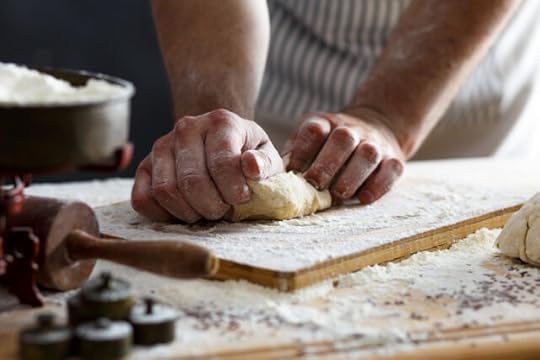
Dear Mark,
You talk a lot about the evils of grains. I follow your logic on why a grain free diet is best, and I have seen weight loss and just feel better overall since heeding your advice. But there is one thing (well, more than one) that I don’t understand but hear about often. Could you explain what gluten intolerance is and why you should avoid gluten?
Excellent question. Even though we’re seeing gluten-free labeling more and more, it’s not always clear why gluten can be problematic. Because of cross-contamination, it’s not always obvious whether a food contains gluten or not. Further, gluten intolerance symptoms can masquerade as other conditions. Let’s break it all down.
What is Gluten?
Gluten is a large, water-soluble protein that creates the elasticity in dough. It’s found in grains such as wheat, rye, barley, triticale, and oats. These days it’s also found in additives like thickeners and fillers used in everything from lunch meat to soup to candy. You can also find gluten in beers and vinegars that have been fermented from gluten-containing grains.
What Is Gluten Intolerance?
If your body reacts when you eat gluten-containing foods, there’s a chance you may have gluten intolerance.
Gluten Intolerance or Sensitivity Symptoms
When an affected person eats or drinks something containing gluten, the protein initiates a kind of allergic reaction in the body, resulting in some level of inflammation. The reaction can vary significantly from person to person. Symptoms include:
Skin changes (rash, itching, scaling)
Fatigue
Joint pain
Acid reflux
Mood changes
Abnormal menses
Digestive discomfort
Some gluten sensitive people show no symptoms, at least for a certain period of their lives.
Gluten Intolerance vs. Celiac Disease
In serious cases, gluten intolerance causes intestinal atrophy known as Celiac disease. Celiac disease is hereditary, and it is estimated that 1 in 10 people with a first-degree relative (parent or sibling) who has celiac disease will also have the condition.1 Unfortunately, not everyone who develops Celiac disease will have recognizable symptoms before the condition has wreaked serious havoc in the intestinal system by flattening of the intestinal villi and subsequently decreasing the area for nutrient absorption. For these people, Celiac disease often isn’t diagnosed until after effects of malnutrition have set in (lack of growth in children, diarrhea, stomach pain and/or bloating, vomiting, behavioral changes, etc.). In these cases, biopsies are often taken to assess the extent of damage and to aid diagnosis. Even if biopsies are normal, there is still the chance that nutrient absorption is impaired.
Thankfully, methods for diagnosing gluten sensitivity and related Celiac disease have improved in recent years as awareness has increased and more research has been done. Blood tests for specific antibodies have allowed physicians to diagnose the disease in many cases before much if any damage has occurred. Researchers are also beginning to test for antibodies in the intestinal tract, which may promise an even earlier diagnosis in at-risk individuals.
Is Gluten Intolerance Common?
Gluten sensitivity or intolerance, once thought to be rare, is now believed to affect a third of the population. (Some believe this number is substantially higher.) Experts report that up to 100 million Americans will consume gluten-free food products over the course of a year.2 It’s considered a genetically influenced, life-long condition, with some relationship to autoimmunity.3 It can appear at any point throughout your lifetime, and sometimes doesn’t manifest itself until a person is in their thirties or even forties.
Given my stance on grains, I obviously suggest avoiding gluten. As mentioned, gluten intolerance is a very common condition and may be underestimated still. Given the relatively recent introduction of gluten (and all grains) into the human diet, gluten intolerance and the related Celiac disease are very unfortunate but not very surprising conditions. In addition to omitting grains from your diet (especially those listed above), you can avoid processed foods, which likely contain trace amounts in forms like hydrolyzed proteins, starch/modified starch, malt, binders, and natural flavorings. If anyone in your family has been diagnosed with Celiac disease or gluten intolerance, it’s a wise idea to talk to your doctor about testing options.
What to Do If You Suspect You Are Gluten Intolerant
If you think you are having reactions to gluten, visit your doctor to rule out celiac disease. Then, it’s simply a matter of avoiding gluten. It’s difficult at first, but soon, you won’t miss them.
Foods that Contain Gluten
Gluten is present in only grains and grain-based foods. Ingredients to look out for if you’re avoiding gluten include:
Wheat
Oats if not labeled gluten-free (If they’re grown too close to wheat crops, you may end up with rogue wheat grains in the mix.)
Barley
Rye
Triticale
When you’re Primal, you avoid grains, so you may be avoiding gluten by default.
Gluten-free grains, starches and flours
If you’re avoiding gluten and buying replacement foods, you may see ingredients including:
Amaranth
Rice
Arrowroot
Almond flour
Sorghum
Buckwheat
Cassava root
Teff
Corn
Flaxseed
Coconut flour
Potato starch
Millet
Quinoa
Soy
Tapioca
Just because it’s gluten free doesn’t mean it’s healthy or Primal. Read this article on grains before you decide to dig in. This article lists flours that are Primal-friendly.
References https://celiac.org/about-celiac-disease/what-is-celiac-disease/https://www.sciencedirect.com/science/article/abs/pii/S0016508515000293https://www.sciencedirect.com/science/article/abs/pii/0167569992900208
The post Dear Mark: Gluten Sensitivity, Intolerance, Celiac Disease, and Grains appeared first on Mark's Daily Apple.



June 27, 2020
Gluten Free Nashville Style Hot Chicken Recipe
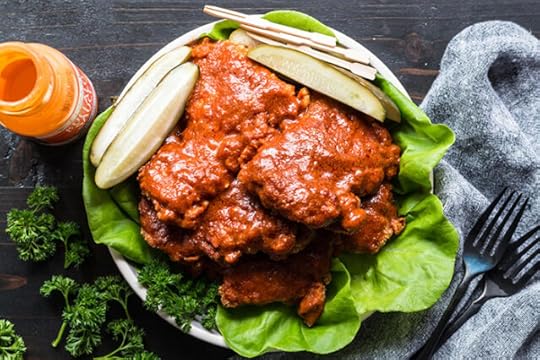 Chicago is known for its deep dish pizza. In Southern California, you have tacos on every corner. Philadelphia loves their cheesesteaks. And you know you’re in Nashville when every third restaurant claims they have the best Hot Chicken in town.
Chicago is known for its deep dish pizza. In Southern California, you have tacos on every corner. Philadelphia loves their cheesesteaks. And you know you’re in Nashville when every third restaurant claims they have the best Hot Chicken in town.
If you’re looking for the crispy kick of hot chicken but you’re nowhere near Music City, we’ve got you covered. Our Nashville Hot Chicken recipe tastes just like the real thing, without the fried food hangover from oxidized frying oil and grain-based breading. Yes, it can be done.
This recipe is fairly involved, but it’ll be worth it in the end.
Not sure about the heat factor? You can adapt this recipe from slightly zingy to three-alarm fire. If you want to break a sweat, taste the coating mixture and the hot chicken sauce before you apply, and add more cayenne. If you want to scale back the spice level, simply reduce the cayenne pepper accordingly. If you want your chicken to have just a subtle zip, you can completely omit the cayenne. The chicken will still have a nice kick thanks to the Primal Kitchen® Buffalo Sauce.
The best way to make the prep for this dish run smoothly is to set up a station with three coatings. Move the chicken like an assembly line down each coating mix. Some of the almond flour coating will clump up as you start dredging the chicken in it. That’s okay! Press these clumps into the chicken as you bread. It will create great texture for the final product.
If you don’t have chicken thighs, you can use chicken breast. Follow the same directions, and bake at 400 degrees instead. You can also lightly spray the chicken with a spritz of Primal Kitchen Avocado Oil Spray prior to baking to prevent the chicken from drying out.
We used coconut sugar in the sauce since it melts with heat and helps the sauce come together. If you’d prefer to use a sugar substitute, your best bet may be a liquid sweetener, like a monk fruit extract based sweetener, but we have not tested this substitution.
Here’s how to make it.
Gluten Free Nashville Style Hot Chicken Recipe
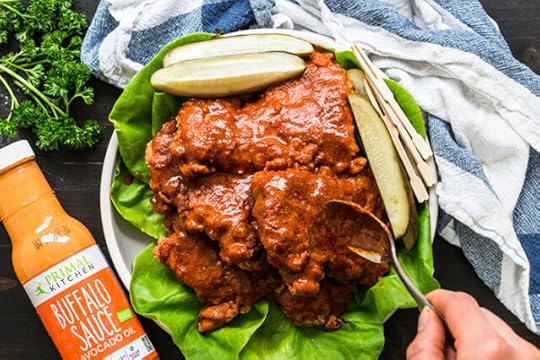 Ingredients
Ingredients1 lb. boneless chicken thighs
1 cup almond flour
7 Tbsp tapioca starch
? cup coconut milk (or other full-fat milk)
¼ cup Primal Kitchen Buffalo Sauce
1 Tbsp coconut flour
1 tsp lemon juice
½ tsp paprika
½ tsp onion powder
½ tsp garlic powder
½ tsp salt
½ tsp black pepper
?-1/4 tsp cayenne pepper
Butter lettuce or iceberg lettuce
Pickles
Sauce
1.5 Tbsp Primal Kitchen Avocado Oil
3 Tbsp Primal Kitchen Buffalo Sauce
3 Tbsp water
1 tsp paprika
1 tsp sweetener
¼ tsp cayenne pepper
¼ tsp chili powder
¼ tsp garlic powder
¼ tsp salt
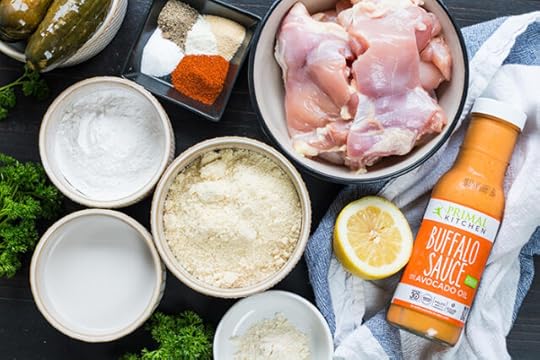
Directions
Pound the chicken between two pieces of parchment paper until they are of even thickness.
Set up three containers or shallow dishes. In the first, mix together two tablespoons of tapioca starch and one tablespoon coconut flour. In the second, mix together the coconut milk, Primal Kitchen Buffalo Sauce and lemon juice. In the third container, mix together the almond flour and remaining tapioca starch.
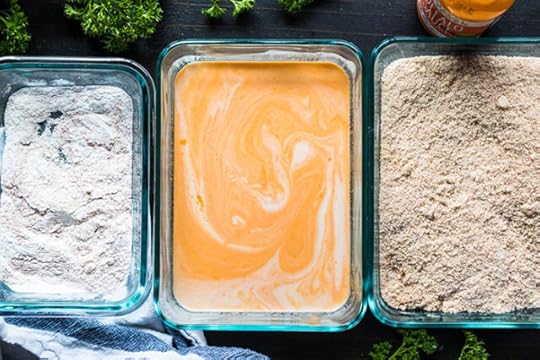 In a small bowl, mix together the paprika, onion powder, garlic powder, salt, pepper and cayenne pepper. Pour about ¼ of this mixture into the container with the coconut flour coating, and the remaining mixture into the container with the almond flour coating.
In a small bowl, mix together the paprika, onion powder, garlic powder, salt, pepper and cayenne pepper. Pour about ¼ of this mixture into the container with the coconut flour coating, and the remaining mixture into the container with the almond flour coating.
Lightly coat the chicken in the coconut flour coating in container 1. Dredge the chicken into the sauce mixture in container 2. Really coat the chicken, turning it multiple times so it picks up a lot of the sauce. Carefully move the chicken pieces one at a time to the container with the almond flour mixture, coating it on all sides. You can also press a little of the coating into the chicken. The mixture will get a little clumpy because of the sauce coating, but that’s a good thing!
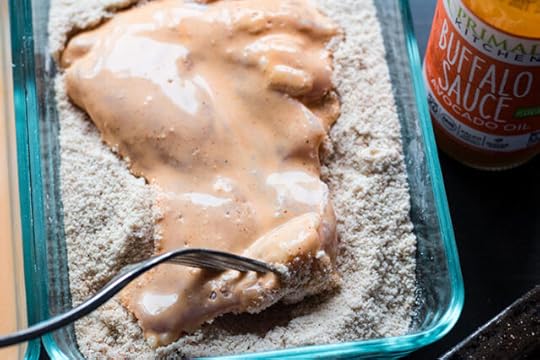
Place the coated chicken on a parchment covered sheet pan and let it rest for 15 minutes. Preheat your oven to 425 degrees during this time.
Place the chicken in the oven for about 20 minutes, or until the chicken reaches an internal temperature of 170 degrees Fahrenheit. The breading is a little delicate, but you can carefully flip the chicken over halfway through the cooking if you are able to.

When the chicken is nearly cooked, prepare the sauce. Heat the avocado oil in a small pan over medium heat. Add the paprika, sweetener, cayenne pepper, chili powder, garlic powder and salt and whisk together. When the sauce comes together, add in the buffalo sauce and keep whisking. The sauce will begin to thicken. Add the water 1 tablespoon at a time until the sauces reaches a silky texture.
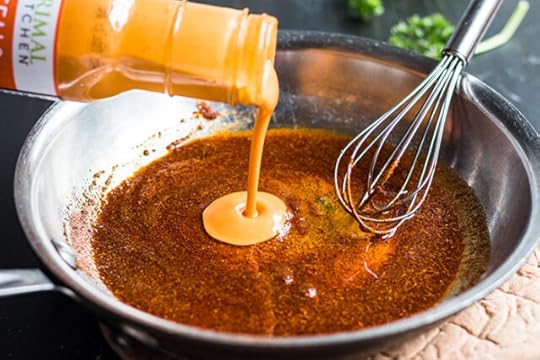 When the chicken is finished cooking, spoon the sauce all over the chicken thighs.
When the chicken is finished cooking, spoon the sauce all over the chicken thighs.
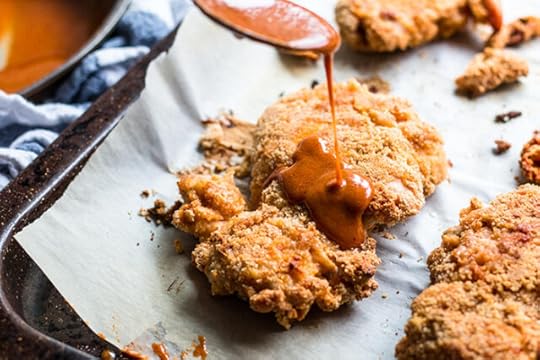 Serve immediately wrapped in butter lettuce and garnish with a pickle spear.
Serve immediately wrapped in butter lettuce and garnish with a pickle spear.
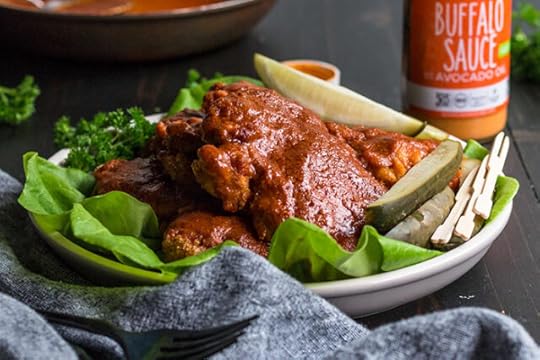
The post Gluten Free Nashville Style Hot Chicken Recipe appeared first on Mark's Daily Apple.



June 26, 2020
Weekly Link Love—Edition 87

Research of the Week
Yoga promotes stress resilience.
Adipose tissue is limited by the number of embryonic progenitor cells.
Relying only on antibody testing may not capture everyone with coronavirus immunity.
Birds who swallow fish eggs whole may deposit them intact and viable into isolated lakes.
New Primal Blueprint Podcasts
Episode 430: Shawn Baker MD: Host Elle Russ chats with Dr. Shawn Baker about all-things carnivory.
Primal Health Coach Radio, Episode 66: Laura and Erin chat with Tara Garrison.
Media, Schmedia
What happened to schools and daycares that remained open despite the pandemic?
Interesting Blog Posts
How one man thinks we can solve the pandemic, and quickly.
What Mel Joulwan is up to these days.
Social Notes
What we’ve lost (but can regain).
One opinion on differences between China and America.
Everything Else
Macaques take over a Thai city.
When did the chicken cross the road?
Things I’m Up to and Interested In
I’m not surprised: There is a strong bias in which antidepressant trials get published.
Interesting finding: It’s not that power poses work. It’s that slumping is bad for your mental health and fortitude.
Video I liked: The power of swimming in wild open water.
Counterintuitive result that might not be so counterintuitive when you really think about it: “Enrichment” activities are probably bad, or at least neutral, for kids.
Now I’m worried: .
Question I’m Asking
How are you playing these days?
Recipe Corner
Battered shrimp tacos that won’t harm your mitochondria.
Crispy pork with asparagus hash.
Time Capsule
One year ago (Jun 21 – Jun 27)
Intermittent Fasting for Athletes: Benefits and Concerns – What to keep in mind.
12 Intermittent Fasting Tips for Athletes – A few tips.
Comment of the Week
“You missed the most important part…how to eat it! You have to pull the bottom of each leaf thru your teeth. I’ve seen people trying to bite and chew the ends.”
– Indeed, Cate. Sidenote: I would support a GMO artichoke whose leaves you could eat in their entirety.
The post Weekly Link Love—Edition 87 appeared first on Mark's Daily Apple.



June 25, 2020
The Definitive Guide to Cholesterol
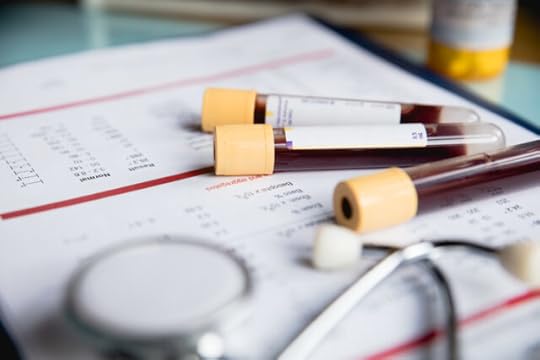 Contrary to what we’ve been told, cholesterol didn’t evolve to give us heart disease. It’s not here to kill us. The actual roles of cholesterol in the body include insulating neurons, building and maintaining cellular membranes, participating in the immune response, metabolizing fat soluble vitamins, synthesizing vitamin D, producing bile, and kick-starting the body’s synthesis of many hormones, including the sex hormones. Without cholesterol, it’s true that we wouldn’t have heart disease, but we also wouldn’t be alive.
Contrary to what we’ve been told, cholesterol didn’t evolve to give us heart disease. It’s not here to kill us. The actual roles of cholesterol in the body include insulating neurons, building and maintaining cellular membranes, participating in the immune response, metabolizing fat soluble vitamins, synthesizing vitamin D, producing bile, and kick-starting the body’s synthesis of many hormones, including the sex hormones. Without cholesterol, it’s true that we wouldn’t have heart disease, but we also wouldn’t be alive.
Given all the work cholesterol has to do, the liver is careful to ensure the body always has enough, producing some 1000-1400 milligrams of it each day. Dietary cholesterol is a relative drop in the bucket. And besides, the liver has sensitive feedback mechanisms that regulate cholesterol production in response to how much you get from your diet. Eat more cholesterol, make less in the liver. Eat less, make more in liver.
Now, if cholesterol is so important, why do we worry about it at all? How has it garnered such a bad reputation for giving us heart attacks?
History of Cholesterol and Heart Disease
Heart disease took off in the early part of the twentieth century, and doctors frantically searched for the cause throughout the next several decades. Early studies in rabbits found that feeding them dietary cholesterol reliably increased blood cholesterol levels and induced atherosclerosis that very much resembled human atherosclerosis. Human tests in the fifties initially showed an association between early death by heart disease and fat deposits and lesions along artery walls. Because cholesterol was found to be present in those deposits and because researchers had previously associated familial hypercholesterolemia (hereditary high blood cholesterol) with heart disease, they concluded that cholesterol must be the culprit.
And while it’s true that cholesterol is involved in heart disease, the direct cause-and-effect relationship has not been established. The reality is far more complicated. To get closer to the reality, we must first understand what these cholesterol numbers actually mean.
Cholesterol versus Lipoproteins
Back in those early rabbit studies, researchers discovered a curious thing: even though feeding the rabbits cholesterol spiked their blood cholesterol and gave them heart disease, bypassing the first step and injecting it directly into the blood had no effect. It was completely harmless.
As it turns out, cholesterol doesn’t normally float around the blood by itself. It is contained within lipoproteins. You can think of lipoproteins as delivery vessels. They contain cholesterol, antioxidants, and fatty acids and along the surface have various proteins that direct the lipoprotein to different sites around the body. It’s not the cholesterol that is involved with atherosclerosis. It’s the lipoprotein.
Let’s play the freeway analogy game. Both LDL-cholesterol (LDL-C) and HDL-cholesterol (HDL-C), the standard, basic readings you get from the lab, do not reflect the number of LDL or HDL lipoproteins, or particles, in your serum. Instead, they reflect the total amount of cholesterol contained in your LDL and HDL particles. Hence, the “C” in LDL/HDL-C, which stands for “cholesterol.” Measuring the LDL/HDL-C and then making potentially life-changing health decisions based on the number is like counting the number of people riding in vehicles on a freeway to determine the severity of traffic. It’s data, and it might give you a rough approximation of the situation, but it’s not as useful as actually counting the number of vehicles. A reading of 100 could mean you’re dealing with a hundred compact cars, each carrying a single driver, or it could mean you’ve got four buses carrying 25 passengers each. Or it could be a couple buses and the rest cars. You simply don’t know how bad (or good) traffic is until you get a direct measurement of LDL and HDL particle number.
How does this relate to heart disease?
In my opinion, the most convincing heart disease hypothesis goes like this:
LDL receptors normally “receive” LDL particles and remove them from circulation so that they can deliver nutrients and cholesterol to cells, and fulfill their normal roles in the body.
If LDL receptor activity is downregulated, LDL particles clear more slowly from and spend more time in the blood. Particles accumulate.
When LDL particles hang out in the blood for longer stretches of time, their fragile polyunsaturated fatty membranes are exposed to more oxidative forces, like inflammation, and their limited store of protective antioxidants can deplete.
When this happens, the LDL particles oxidize.
Once oxidized, LDL particles are taken up by the endothelium – a layer of cells that lines the inside of blood vessels – to form atherosclerotic plaque so they don’t damage the blood vessel. This sounds bad (and is), but it’s preferable to acutely damaging the blood vessels right away.
So it’s the oxidized LDL that gets taken up into the endothelium and precipitates the formation of atherosclerotic plaque, rather than regular LDL. OxLDL, poor receptor activity, and inflammation are the problems.
If that’s the case, what exactly is the deal with traditional blood lipid numbers—the ones you get on a standard blood test?
This information is how I view cholesterol as it relates to my individual biology. If you have questions about your cholesterol numbers, discuss them with a qualified health professional.
Total Cholesterol
Standard view: Get that TC below 200, or else you’ll have a heart attack or you’ll have to pay a higher health insurance premium, if the insurers take you on at all.
My take: Mostly meaningless. Even though the epidemiological evidence suggests a TC between 200 and 240 mg/dl is best for all-cause mortality,1 we can’t hang our hats on it. First off, total cholesterol is limited because it’s only telling us the amount of cholesterol contained in all our lipoproteins without saying anything about what kind of lipoproteins we have or how many there are. Second, total cholesterol is limited because it’s determined by a bizarre formula – HDL-C+LDL-C+(Triglycerides/5) – that reduces various types of blood lipids, each with a different role in the body and a unique impact on our risk for illness, to mere numbers. Someone with low HDL and high triglycerides could easily have the same TC as someone with high HDL and low triglycerides, so long as the numbers work out. Whether it’s being used to predict wellness or disease, total cholesterol by itself is mostly meaningless.
HDL Cholesterol
Standard view: “Good” cholesterol. It’s the “garbage truck” that cleans up “excessive” cholesterol and fat from tissues, so the higher the better! Though men and women should strive for levels exceeding 60 mg/dl, above 40 is acceptable for the former and above 50 is acceptable for the latter.
My take: Higher HDL-Cs correlate strongly with better cardiovascular health. No real argument here. Higher HDLs are desirable. Just remember, it’s only a snapshot of a glimpse into the cholesterol content of your HDL particles. Among most groups tested, the TC:HDL ratio is actually a strong indicator of heart disease risk, with higher ratios corresponding to higher risks. Note, though, that no Primal Blueprint adherents were among the groups analyzed, ever.
LDL Cholesterol
Standard view: Get it as low as humanly possible! I want that low density lipoprotein so low as to be nearly nonexistent. Your body obviously hates you; otherwise, it wouldn’t be producing a potently toxic substance and sending it directly into your endothelial cells to form atherosclerotic plaque! Of course, we’re not actually measuring the number of low density lipoproteins, just the amount of cholesterol contained in them, but still!
My take: While a high LDL-C may indicate a problem, remember that LDL-C only indicates the total amount of cholesterol in your LDL particles. You could easily have a few large particles (good) or a bunch of smaller, denser ones (bad, might indicate poor LDL receptor activity and an LDL that likes to hang out in the blood), but LDL-C alone isn’t enough to know. It’s also just a moment in time, whereas what you’re interested in is the trend. If the trend indicates a steady rise in LDL-C, however, that could hint at poorer LDL clearance and lower LDL receptor activity (and greater susceptibility to oxidation).
Triglycerides
Standard view: Lower would be better, sure, but you really gotta do something about that LDL! Anything less than 150 mg/dl is fine.
My take: High triglycerides correlate strongly with low HDL and smaller, denser LDL. High triglycerides, then, could indicate more oxidized (or oxidizable) LDL. The triglycerides of most Primal eaters, especially those on the lower carb side of things, usually hover well below 100 mg/dl. Triglycerides come packaged in VLDL, or very low density lipoproteins (which are calculated by dividing your triglyceride count by 5).
So, what can we learn from a standard lipid test? If we take a series of regular ol’ lipid measurements, preferably one pre- and several peri-Primal, we can get an idea of our metabolic health. Look for:
Trends – Are your triglycerides going down over time? That’s great. Is your HDL trending up? Also good.
Normal fluctuations – Your numbers can jump around 20-30 points in either direction between readings without it necessarily meaning anything.
TC:HDL-C ratio – Lower is better and indicates fewer LDL particles.2
Triglyceride:HDL-C ratio – Lower is better and indicates larger LDL (and, usually, fewer) particles. Ideally, this will be close to 1 or lower; one study (PDF) found that 1.33 was the cut off.34
There is an advanced lipid test that’s worth getting: ApoB.
Apolipoprotein B
Every single LDL particle has a single ApoB, making ApoB an effective measurement of LDL particle count. By all accounts I could find, ApoB is reliable and accurate. Every LDL particle has one ApoB, and along with TC:HD ratio, ApoB count is a strong predictor of heart disease risk (again, with the caveat that these studies are on populations leading a decidedly unPrimal and highly inflammatory lifestyle).5 If you have a lot of ApoB, you have a lot of LDL particles, which could mean the LDL receptor activity is down-regulated. Or, it could mean you’re losing weight, which can affect lipid values in multiple ways. Or, it could mean that today was a particularly “high ApoB day” and that getting it tested next week will give a different result, simply due to natural fluctuations. You just don’t know.
And that’s actually the main issue with all cholesterol readings, however advanced: They are snapshots in time. They do not capture the natural fluctuations and trends of the biomarkers. Your cholesterol was elevated today at 12 noon. What does that say about your levels tomorrow at six in the evening? Next week? Nothing. To account for natural fluctuations, get tested at regular intervals and observe the trends.
If you can’t get the ApoB test, total cholesterol/HDL ratio is a good indicator of how long LDL is hanging around in the blood and remains the best standard assessment of heart disease risk. Another good one is triglyceride/HDL ratio, which is a strong surrogate marker for insulin resistance. In both cases, lower is better. An ideal T/HDL ratio is 1:1; 2:1 is about as high as you want to go. An ideal TC/HDL ratio is 3.5:1 or lower.
Okay, so by whatever metric you want to use, your numbers are “elevated” and you’ve taken enough readers to get a general trend. It’s not just an isolated number. Should you worry?
Is High Cholesterol a Problem?
Oh, boy. There’s the million dollar question.
First off, let’s go back to the evolutionary prism. As a naturally self-regulating system, the body isn’t going to produce something that is intrinsically pathological. Maybe that could happen in really rare genetic mutations, but everyone produces, utilizes, and relies upon cholesterol. It simply doesn’t make sense that cholesterol is evil.
Adequate cholesterol isn’t available for the body’s repair system, for the uptake of serotonin, for the full initiation of Vitamin D and hormone production and their regulation of blood sugar and inflammation, etc., etc. What does your logic tell you here? Yup, nothing is running the way it should.
Let me also add that everyone’s cholesterol profile is going to be different, no matter what. And I acknowledge that a very small percentage of people out there genuinely have *true* hereditary high blood cholesterol, familial hypercholesterolemia, a metabolic condition with impaired or even lack of ability to metabolize cholesterol. This condition can have serious health consequences. By the way, this condition, in its heterozygous form affects at most 1 in 500 people. Total serum cholesterol in these folks is in the 400 mg/dl range (as opposed to the 200 recommended). The homozygous form affects about 1 in 250,000. You likely don’t know anyone in this category because their disorder almost always ends their lives at a very young age. But even the heart disease common in familial hypercholesterolemia might not be caused solely by high LDL, but by poor coagulation.6
But if you’re eating a healthy diet, your performance is good, your body comp is good (or trending that way), your energy and sleep are rock-solid, you don’t have any familial hypercholesterolemia genes—is it really dangerous to have elevated cholesterol numbers?
I don’t know. But I’m skeptical.
For one, “elevated” cholesterol isn’t necessarily linked to heart disease. Sometimes it’s even linked to lower mortality. For instance, in people older than 60, high LDL is associated with lower all-cause and cardiovascular mortality.7 That’s right: higher LDL, less heart disease deaths. Plus, most people who have major heart attacks have “normal cholesterol.”
I’ve said it before, and I’ll say it again. Sound and reliable medical research hasn’t proven that lowering (or low) cholesterol in and of itself reduces risk of death from heart disease across a population. What does this tell you? There must be some other piece or pieces to the cholesterol/heart disease story.
Based on my examination of the evidence over the years, it all boils down to oxidative stress and inflammation.
The inflammatory response and subsequent oxidative stress load is ultimately responsible for the oxidation of the LDL, while inflammatory cytokines produced at the atherosclerotic site can weaken and loosen the plaque, thus setting the stage for (and even causing) a rupture. In fact, inflammation is intimately involved in nearly every aspect of heart disease.89
Furthermore, nearly every study suggests that LDL is only a true threat when it’s oxidized. What increases the risk of oxidized LDL?
Having LDL particles that hang out longer in the blood.
Eating too much linoleic acid (it’s the polyunsaturated fat in the lipoprotein that oxidizes).10
Being deficient in vitamin E.
Having type 2 diabetes and/or high blood sugar.11
Failing to eat grass-fed dairy.12
Not exercising.13
Not eating extra virgin olive oil and fish oil.14
To name a few. Could “high” LDL particles be closer to benign if they’re more resistant to oxidation? I would imagine so. Does resistance mean immunity to oxidation? Absolutely not. Don’t get cocky.
Substantially “elevated” cholesterol, low HDL or high LDL can be a real problem, but they may also just be a symptom of the larger concern rather than the main issue itself. Cholesterol profile can be impacted by other conditions such as hypothyroidism, untreated diabetes or pre-diabetes, pregnancy (surprise!), lactation, stress, liver conditions, heart disease (symptom, not cause of). Even weight loss or fasting can spike cholesterol numbers (turns out burning all that animal fat off your body can have a momentary effect on blood lipids). Talk to your doctor about what your numbers mean in the grand scheme of your health. And see if you can get a read on other markers, like C-reactive protein (an inflammatory indicator), oxidized LDL, and ApoB (or some other marker of LDL particle number).
High cholesterol shouldn’t be ignored, but it’s not the only thing that matters. You have to look at the whole picture. You have to take a step back (or several steps back) and consider everything—not just numbers on a readout.
If you have any more questions about this topic, drop them down below. Thanks for reading, everyone. Take care.
References http://perfecthealthdiet.com/wp/wp-content/uploads/2011/06/O-Primitivo-Cholesterol.jpghttps://www.ncbi.nlm.nih.gov/pubmed/19903920https://www.ncbi.nlm.nih.gov/pubmed/19091534https://www.google.com/url?sa=t&rct=j&q=hdl%20tg%20ratio&source=web&cd=4&ved=0CE8QFjAD&url=http%3A%2F%2Fcare.diabetesjournals.org%2Fcontent%2F23%2F11%2F1679.full.pdf&ei=mvPxTrDtMY7XiALm8OW5Dg&usg=AFQjCNE3GzGevscRzugAZXArj9BWCqn9eA&sig2=nhtWZ_ze7r3xudNliKrTYQhttps://www.ncbi.nlm.nih.gov/pubmed/19903920https://www.sciencedirect.com/science/article/abs/pii/S0306987718304729https://pubmed.ncbi.nlm.nih.gov/27292972/http://atvb.ahajournals.org/content/20/6/1536.fullhttps://www.ncbi.nlm.nih.gov/pubmed/16470012https://www.sciencedirect.com/science/article/abs/pii/0891584993900745https://www.ncbi.nlm.nih.gov/pmc/articles/PMC4940560/https://pubmed.ncbi.nlm.nih.gov/21591986/https://pubmed.ncbi.nlm.nih.gov/29190851/https://pubmed.ncbi.nlm.nih.gov/10451477/
The post The Definitive Guide to Cholesterol appeared first on Mark's Daily Apple.



Ask a Health Coach: Sleep, Weight Loss Stalls, and Skipping the Gym
 How bad is working and eating late at night? Wondering why you’re not losing weight? And what if you don’t want to go back to the gym? In this week’s edition of Ask a Health Coach, Erin is back to answer more of your questions. Keep them coming in the comments below or over in our Mark’s Daily Apple Facebook Group.
How bad is working and eating late at night? Wondering why you’re not losing weight? And what if you don’t want to go back to the gym? In this week’s edition of Ask a Health Coach, Erin is back to answer more of your questions. Keep them coming in the comments below or over in our Mark’s Daily Apple Facebook Group.
Jacob asked:
“My nighttime habits are the worst. I stay up too late working, then I’m hungry and go looking for a snack at 1 or 2 am. I don’t think I should be working and eating that late, but how bad is it really?”
Your intuition is spot on here, Jacob. The late-night artificial light. The late-night insulin spike. The stress of a disrupted sleep cycle. It all comes down to your circadian rhythm, which as reiterated in this study, 15 can lead to a myriad of metabolic ramifications. For those not familiar with circadian rhythm, it’s basically your internal, 24-hour cycle of biochemical, physiological, and behavioral processes.
Stay on track no matter where you are! Instantly download your Primal and Keto Guide to Dining Out
Some things help it work optimally. Other things like blue light, nighttime snacking, and even the temperature of your room can cause disruptions. If you’re staying up late working — and not wearing blue-light blocking glasses — you’re compromising the amount of melatonin you produce. Melatonin is the sleep hormone and having less of it will make you feel more alert and even disrupt your REM sleep. 16
Late-night snacking can make the problem worse. Not because “eating late at night causes you to store fat” (as our misinformed culture likes to tell us), but because, in a manner of speaking, your body can either produce metabolism hormones or sleep hormones — not both at the same time. The production of melatonin will slow or cease in order to metabolize your evening snack. This study from scientists at Universidade Federal de São Paulo in Brazil backs it up, finding that men and women who consumed high amounts of calories right before bed spent even less time in REM sleep.17
On top of that, you’re at greater risk for diabetes when your sleep is compromised on a regular basis.
I’ll stop the lecture here since my guess is that you’re already in tune with a lot of this info. So, my question to you is: what’s preventing you from doing what you need to do? If the idea of totally revamping your nighttime routine feels overwhelming, think about small steps you could take.
Could you do some of your work in the early morning instead of at night?
Could you print out what you’re looking at instead of viewing it on a screen?
Could you stop eating once the clock hits 9pm?
Could you go to bed earlier 3 nights this week?
You don’t have to do all of these at once. But by taking actionable steps to shift your melatonin production, you’re doing yourself and your circadian rhythm a huge favor. Not only will you get a better night’s sleep, you’ll feel more energetic, focused, and productive during the next day.
Karin asked:
“Now that my gym is open, I’m trying to go 3 times a week, but most weeks I’m only going once and sometimes not at all. I’m really beating myself up about it.”
Listen, you probably spent the past several weeks adapting to a new normal of working and working out from home. So, jumping into another new routine might not be as easy as just deciding you’re going to do it.
But beating yourself up about it won’t do you any good.
Your resistance to getting to the gym could be based on a few different things. And the more you understand where that resistance is coming from, the better off you’ll be. Since your gym is open again, you might feel like you should be going, especially if you’re getting charged for your membership. After all, who wants to waste good money?! But when you say things like “I should go to the gym” or “I should have lost weight by now” you’re really just judging yourself.
You’re holding yourself to the standards that either someone else has made up for you, or standards that might not make sense for where you are right now.
Ask yourself why it’s important for you to go to the gym 3 times a week. Is it because you can? Because that’s what you did before the stay-at-home orders started? Because your neighbors are posting about it on Facebook?
Hopefully some of these questions will get your wheels turning. You might even discover that you actually felt better about yourself by NOT going to the gym to do your workouts. Maybe you realized that, because you’ve been forced out of society for a bit, that being surrounded by floor-to-ceiling mirrors, fluorescent lighting, and cellulite-free bodies is not your idea of a good time. Maybe subconsciously comparing yourself to the uber-fit person on the elliptical trainer next to you makes you temporarily forget how miraculous your body really is.
If optimal health is your goal here, it’s essential to remember that your mental state is as important as having rock hard abs.
Sarah asked:
“I need a little help figuring out what I am doing wrong. I started eating Primally about 3 months ago, and after initially losing 10 pounds, the scale hasn’t budged! What gives?”
I hear this a lot with my own clients. So, trust me, you’re not alone. Who doesn’t love the exhilaration of watching the scale go down? Or seeing a number (that in your mind is too big) get smaller?
I get it.
Here’s the thing though. Weight loss isn’t necessarily what you want. What you really want is fat loss, which may or may not show up on the scale. Take for instance a study where female participants were assigned to either a low-protein diet of 68 grams of protein per day or a high-protein diet of 125 grams a day. Both diets had the same number of calories, AND both groups lost about the same number of pounds. However, the high-protein group ended up losing more fat and less muscle.18
I admit that the scale is the easiest way to measure your progress, but it’s not the most accurate. Most often, when the number changes, it’s due to fluctuations in things like water, glycogen, and waste. Even if the number is consistently going down, there could be a good chance you’re losing lean muscle tissue, not fat!
So, instead of focusing on an utterly pointless number that’s not moving — or moving in the wrong direction — there are better indicators that your body is losing fat. Here are some of my favorites:
Your pants feel looser
Your tops close more easily
Your face looks slimmer
You’re sleeping better
You’re less hungry in between meals
You have more energy
People are asking if you’ve lost weight
If you’re really interested in knowing how well you’re doing, go ahead and get out the measuring tape. I had a client once who would measure herself consistently each Sunday, keeping an Excel spreadsheet of every single change. From week to week, she was seeing only small changes, but when she looked at the data over the course of a few months it was pretty mindblowing.
References http://perfecthealthdiet.com/wp/wp-content/uploads/2011/06/O-Primitivo-Cholesterol.jpghttps://www.ncbi.nlm.nih.gov/pubmed/19903920https://www.ncbi.nlm.nih.gov/pubmed/19091534https://www.google.com/url?sa=t&rct=j&q=hdl%20tg%20ratio&source=web&cd=4&ved=0CE8QFjAD&url=http%3A%2F%2Fcare.diabetesjournals.org%2Fcontent%2F23%2F11%2F1679.full.pdf&ei=mvPxTrDtMY7XiALm8OW5Dg&usg=AFQjCNE3GzGevscRzugAZXArj9BWCqn9eA&sig2=nhtWZ_ze7r3xudNliKrTYQhttps://www.ncbi.nlm.nih.gov/pubmed/19903920https://www.sciencedirect.com/science/article/abs/pii/S0306987718304729https://pubmed.ncbi.nlm.nih.gov/27292972/http://atvb.ahajournals.org/content/20/6/1536.fullhttps://www.ncbi.nlm.nih.gov/pubmed/16470012https://www.sciencedirect.com/science/article/abs/pii/0891584993900745https://www.ncbi.nlm.nih.gov/pmc/articles/PMC4940560/https://pubmed.ncbi.nlm.nih.gov/21591986/https://pubmed.ncbi.nlm.nih.gov/29190851/https://pubmed.ncbi.nlm.nih.gov/10451477/https://www.ncbi.nlm.nih.gov/pmc/articles/PMC5142605/https://academic.oup.com/jcem/article/89/1/128/2840303)https://jcsm.aasm.org/doi/10.5664/jcsm.1476https://pubmed.ncbi.nlm.nih.gov/12566476/
The post Ask a Health Coach: Sleep, Weight Loss Stalls, and Skipping the Gym appeared first on Mark's Daily Apple.



June 23, 2020
What Is Monk Fruit Sweetener, and Is It Keto?
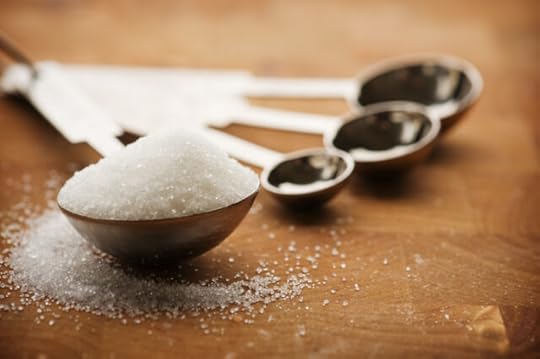 When you give up sugar, that doesn’t mean you have to give up sweet treats. You can find natural ways to satisfy your sweet tooth without spiking your blood sugar, and that doesn’t mean you have to resort to dangerous artificial sweeteners. Monk fruit is a keto community favorite ingredient to sweeten recipes, but what exactly is it, and where does it come from? Is there any research behind monk fruit? And how do we compare the various formulations next to each other in the supermarket aisle? Let’s break this down.
When you give up sugar, that doesn’t mean you have to give up sweet treats. You can find natural ways to satisfy your sweet tooth without spiking your blood sugar, and that doesn’t mean you have to resort to dangerous artificial sweeteners. Monk fruit is a keto community favorite ingredient to sweeten recipes, but what exactly is it, and where does it come from? Is there any research behind monk fruit? And how do we compare the various formulations next to each other in the supermarket aisle? Let’s break this down.
What Is Monk Fruit?
We’ve covered stevia, yacon syrup, allulose, and Swerve, but what about another popular choice in the growing selection of natural sweeteners — monk fruit? Known as Luo Han Guo in its native southern China, monk fruit (Siraitia grosvenorii) first found acclaim in the records of 13th century Luo Han Buddhist monks. The monks valued the natural sweetness of the fruit and made it their mission to cultivate the vines through the centuries. Today, most monk fruit cultivation still occurs in the misty mountains of China’s Guangxi province1 and a few surrounding areas, where the conditions are just right to grow and harvest the small, orange-sized fruits.
Monk fruit belongs to the cucurbit family alongside squash, cucumber, and watermelon. Fresh off the vine, the mini melons have a bitter outer rind encasing a sweet edible pulp and seeds. But unless you know someone who’s managed to cultivate monk fruit in their garden, you’re unlikely to eat a fresh monk fruit. The flesh degrades quickly, meaning most manufacturers dry monk fruit or process it so that it will make it to market.
Most monk fruit finds its way to American shelves as a concentrated natural sweetener. As always, the nature of that sweetener can vary markedly depending on how it was processed.
Instantly download your Keto Reset Diet Recipe Sampler
Is Monk Fruit Keto?
An average serving of pure monk fruit extract contains virtually no carbs, calories or sugars, which makes it a great choice to sweeten keto desserts and drinks.
It derives almost all of its sweetness from a group of antioxidants 2 called mogrosides, with mogroside V having a sweetness 250 times that of table sugar.3 To put that sweetness in perspective, most people consider just 1/64 of a teaspoon of monk fruit extract to taste as sweet as a full teaspoon of table sugar.
But to get this natural “zero calorie” sweetener, much of the natural compounds in the fruit are lost. Most producers treat “pure” monk fruit sweeteners to remove off-flavors, then they dry it to remove other sulfurous volatiles. Finally, it gets homogenized and pasteurized. The resulting extract is very different from its original state, slightly undermining its purported status as a natural sweetener.
Other less processed natural monk fruit sweeteners provide a more wholesome version of the original fruit, but with the arguable downside of containing a small amount of glucose and fructose. More carbs also tend to mean fewer mogrosides, and hence a lower relative sweetness.
Pure Monk Fruit Sweetener vs. What’s On Grocery Shelves
Contrary to what people might claim, fresh, unprocessed monk fruit is not sugar-free. It varies between cultivar and growing region. Still, fresh monk fruit is typically one-third carbohydrate, composed of a mix of fructose and glucose.
After you extract the juice, much of those carbs are left behind. At this point, a minimally-processed monk fruit extract sweetener might only contain small amounts of sugars in the form of fructose or glucose. At this point, it becomes a low-calorie natural sweetener. A half teaspoon serving of monk fruit juice powder, for example, is made up of 10% sugar, and the rest of the carbs presumably come from of mogrosides and other indigestible sweet-tasting compounds.
At the other end of the scale, pure monk fruit extracts are zero-calorie sweeteners, with no carbs and no sugar. Manufacturers are sometimes hesitant to sell straight monk fruit extract, however, because it’s easy to overdo it when you mix it into recipes. To add bulk, manufacturers will mix in small amounts of other sweeteners like erythritol or xylitol. It’s not uncommon to find sucrose or dextrose lurking on the ingredients list of so-called natural monk fruit sweeteners, but the amounts would be pretty minimal. Check labels to be sure.
While monk fruit contains several different mogrosides, 4 the key ingredient is generally mogroside V. This is easily the sweetest-tasting of all the compounds in monk fruit. Very conveniently, your body does not metabolize it in the same fashion as simple sugars like glucose or fructose. Your digestive system does not readily absorb Mogroside V. This accounts for the “zero calorie” claims of monk fruit extract products. It spells good news for those looking to satiate their sweet tooth while avoiding calorie loading or blood sugar spikes.
Potential Benefits Of Monk Fruit
While the extraction and refining processes remove most of the original natural compounds from fresh monk fruit, research indicates that the mogrosides and other flavonoids that remain can still benefit your body. Here’s a brief look at some of the benefits (preventative and otherwise) you might enjoy using monk fruit sweeteners.
Monk Fruit May Combat Obesity
As Primal folks know, sugar (not fat) is the leading dietary cause of the obesity epidemic. And as the world has ever-so-slowly awakened to the notion that sugar might be doing the most damage, there’s been a push towards sweeteners that don’t elicit the same insulin-meddling, inflammation-elevating, liver-damaging effects as sugar. Preliminary evidence suggests that the mogrosides in monk fruit sweeteners might be just the ticket. A 2012 study showed that total mogrosides extracted from monk fruit “suppressed the increase in body weight, abdominal and epididymal fats weight” in mice placed on a high-fat diet (presumably not good fats).5 Another study showed that obese mice fed mogrosides from monk fruit had significantly reduced body and liver weights compared to control mice.6 Researchers thought that the mogrosides achieved this anti-obesity effect by “enhancing fat metabolism and antioxidative defenses.”
We need more research to verify these findings, especially in humans. But its a promising start.
READ NEXT: Does Monk Fruit Break a Fast?
Antidiabetic Applications
There has been plenty of research into the potential antidiabetic effect of mogrosides found in monk fruit sweeteners. In one study, mogroside extracts from monk fruit administered to diabetic rats significantly eased symptoms and protected against biochemical abnormalities.7
In another study, diabetic rats were fed monk fruit extract for 13 weeks. Those rats fed the monk fruit extract showed improved insulin response, reduced blood sugar levels after glucose administration, and reduced oxidative stress caused by diabetes. What’s more, the monk fruit group also showed signs of lowered kidney damage, a common symptom of advanced diabetes.8
Yet another study showed that both crude monk fruit extract and mogroside V helped to stimulate the secretion of insulin in pancreatic beta cells.9
You get the idea. Once again, more studies in humans are needed to make any definitive conclusions.
Here are some tested and true recipes that use monk fruit:
Possible Anti-cancer Benefits of Monk Fruit
While research is very much in its infancy regarding the link between monk fruit and cancer, there’s likely to be more on the horizon. A 2016 study 10 used mogroside IV, extracted from monk fruit, to inhibit the proliferation of both colorectal and throat cancer cells and suppress tumor growth. An earlier study 11 showed that a range of triterpenoids (including several mogrosides) isolated from monk fruit showed “potent inhibitory effects” on Eppstein-Barr Virus-induced tumor growth.
It makes plenty of sense, as multiple studies have highlighted the antioxidant 12 powers of mogrosides found in monk fruit sweeteners.
Anti-Inflammatory Properties of Monk Fruit
A 2011 study indicated that mogrosides administered to mice significantly reduced inflammation by quieting genes that trigger inflammation and up-regulating anti-inflammatory genes.13
More than half of a more recent study demonstrated the ability of mogroside V to lower induced lung inflammation in mice.14 Researchers have shown that monk fruit extracts reduce physical fatigue in mice (allowing them to swim for longer).15 We can assume that this is at least partially attributed to monk fruit’s anti-inflammatory compounds.
Monk and Immunity
The health-giving powers of monk fruit sweeteners may even extend to immune function. In one study, scientists fed groups of diabetic mice low-dose mogrosides, high-dose mogrosides, or a saline control solution over a month.16 At the end of the trial, both mogroside groups (but particularly the low-dose group) showed significant protection against diabetes-induced immune dysfunction. Interestingly, this immune-bolstering effect was only apparent in immune-suppressed diabetic mice, suggesting it plays a vital role in restoring homeostasis in the body.
Specific monk fruit isolates’ anti-bacterial properties 17 further solidify the immune-boosting effect and prevent the growth of common bacterial pathogens like Streptococcus mutans, Porphyromonas gingivalis, and Candida albicans.
Are Monk Fruit Sweeteners Safe?
Long-term, multi-year toxicity trials the best way to evaluate safety, but so far, no tests have yet revealed anything of concern. People sometimes report digestive discomfort with monk fruit, but some say that it would be due to other things that are mixed with the monk fruit (like xylitol or erythritol) and not the monk fruit itself.
The FDA gave monk fruit products their generally recognized as safe (GRAS) seal of approval in 2010, and it’s of some note that monk fruit has been cultivated and eaten since at least the 13th century, albeit at far lower concentrations.
Limited trials in humans haven’t reported any adverse effects, and a study in mice showed that, mice who consumed high dosages did not experience toxic or mutagenic effects.18 That said, the use of highly concentrated monk fruit sweeteners is very much in its infancy. Moderation is a safe bet.
Tips For Buying and Using Monk Fruit Sweeteners
Which product you choose will depend on your preference. Those who prefer an entirely non-caloric formulation will want to go with pure monk fruit extract. Or you may prioritize less-processed versions, which might contain a small amount of simple sugars and a little less mogroside.
At the other end of the spectrum, those who have a hard time measuring pure monk fruit, or want to cut down on the aftertaste might opt for a blended product that includes erythritol, xylitol, and stevia.
While most people enjoy the taste of monk fruit, it’s not necessarily for everyone. Taste descriptors vary markedly from person to person, with some noting it tastes like caramel or molasses, others more like sweet licorice. Keep in mind that the more refined the monk fruit sweetener, the more it loses its butterscotch character, and the sweeter it will taste.
And speaking of sweetness, remember that mogroside V, the key ingredient in most monk fruit sweeteners, is up to 250 times sweeter than sugar, so a little goes a long way. Most labels provide a sugar substitution guide for recipes.
How to Use Monk Fruit Sweetener
How you use monk fruit sweeteners will also depend on your taste preferences. Some common uses include:
Baked goods
Sauces and salad dressings
Teas
Fruit/vegetable-based drinks
Smoothies
Asian dishes that call for a dash of sweetness
That’s just the beginning. Experiment, and see how it might work for you and your family.
Thanks for stopping by, folks. Have you used monk fruit as a sweetener, or would you consider trying it? Be sure to share your thoughts below.
References https://link.springer.com/chapter/10.1007/978-94-007-1764-0_51https://link.springer.com/article/10.1007/s00216-012-6693-0http://www.pnas.org/content/113/47/E7...https://www.sciencedirect.com/science/article/pii/S0026265X14000733https://academicjournals.org/journal/AJPP/article-abstract/088D6DA28337http://www.mdpi.com/1420-3049/23/8/1894https://onlinelibrary.wiley.com/doi/abs/10.1002/mnfr.200500252https://www.cambridge.org/core/journals/british-journal-of-nutrition/article/antidiabetic-effect-of-longterm-supplementation-with-siraitia-grosvenori-on-the-spontaneously-diabetic-gotokakizaki-rat/FC59DC2955AA96A75154985DAE6809E6https://europepmc.org/abstract/med/21351724http://www.mdpi.com/2072-6643/8/6/360/htmhttps://pubs.acs.org/doi/abs/10.1021/jf0206320 and free radical-scavenging [ref]https://www.sciencedirect.com/science...https://pubs.acs.org/doi/abs/10.1021/jf201207mhttps://www.tandfonline.com/doi/abs/10.3109/13880209.2013.867451https://www.ncbi.nlm.nih.gov/pmc/articles/PMC3813191/http://en.cnki.com.cn/Article_en/CJFDTOTAL-YYXX200603010.htmhttps://www.ncbi.nlm.nih.gov/pubmed/20183321http://en.cnki.com.cn/Article_en/CJFDTotal-AHNY201403050.htm
The post What Is Monk Fruit Sweetener, and Is It Keto? appeared first on Mark's Daily Apple.



June 22, 2020
The Health Benefits of Turmeric, and How to Get More of It
 It may not share cinnamon’s popularity, but turmeric is another spice with powerful culinary and medicinal qualities that deserves our attention. Turmeric, known officially as curcuma longa and historically as Indian saffron, is a rhizome (root) of the ginger family. Its horizontal root system is dug up, baked, and ground into a bright orange powder, which then goes into any number of Middle Eastern, South Asian, and Southeast Asian dishes. Pretty much every curry you come across anywhere, for example, includes a generous portion of turmeric. Common yellow mustard also includes turmeric, mostly as a food colorant. Recently, the health benefits of turmeric have come to light, and people are looking for more ways to get more turmeric into their diets.
It may not share cinnamon’s popularity, but turmeric is another spice with powerful culinary and medicinal qualities that deserves our attention. Turmeric, known officially as curcuma longa and historically as Indian saffron, is a rhizome (root) of the ginger family. Its horizontal root system is dug up, baked, and ground into a bright orange powder, which then goes into any number of Middle Eastern, South Asian, and Southeast Asian dishes. Pretty much every curry you come across anywhere, for example, includes a generous portion of turmeric. Common yellow mustard also includes turmeric, mostly as a food colorant. Recently, the health benefits of turmeric have come to light, and people are looking for more ways to get more turmeric into their diets.
Turmeric imparts a unique flavor: slightly bitter and a bit spicy, with a mustard-like scent. Upon tasting a dab of turmeric powder by itself for the first time, one is reminded of curries and other Asian stews. It’s a bit of an “Aha!” moment – when you taste it, you can finally put your finger on the earthy flavor that’s so common in your favorite dishes from around the world. Turmeric itself is actually fairly mild and unassuming, so using it as a solitary spice won’t turn every dish into a curry bonanza – in case you were worried.
In this article, I’ll cover the health benefits of turmeric, the science behind it, and how to get more of it.
Turmeric and Curcumin Benefits: What the Science Says
Turmeric and extracts of turmeric (curcumin) have been used for ages for a variety of ails, and especially for conditions rooted in inflammation such as:
Certain types of arthritis
Upset stomach
Diarrhea
Headaches
Heartburn
Respiratory issues
Fever
Skin conditions (used topically)
Years ago, I did a short piece on the anti-diabetic, anti-inflammatory effect of turmeric. Turmeric was shown to improve insulin sensitivity and blood glucose levels in rodent models. Mice given the supplement were less likely to develop type 2 diabetes, and they enjoyed greater body fat losses. Good, promising stuff all around.
Curcumin Supplements and Altzheimer’s and Dementia
A growing body of research shows that curcumin may help alleviate the troubling symptoms of age-related cognitive decline. A sampling of the research…
Curcumin supplementation has shown promise in improving and preventing Alzheimer’s disease.1
Sustained low doses of curcumin were actually more effective in reducing beta-amyloid plaques, the hallmark of Altzheimer’s disease, than higher doses.2
Altzheimer’s Disease incidence is lower in regions where turmeric is commonly used in cooking,3 like in India (compared to the United States) and in East Asia (compared to Europe).4
Curcumin May Protect Against Some Cancers
Curcumin may have anti-cancer effects.5 Here are a few of the research studies we have so far.
Curcumin was shown to induce breast cancer cell apopstosis (where cancer cells destroy themselves).6
Unlike many other anticancer agents that suppress the host’s immune system, curcumin may actually restore the immune system.7
Disrupted cell growth is a large factor in cancer development, and curcumin may have a regulatory effect on cell function.8
Large and small bowel cancer rates are relatively low in India, especially among rural folks (eating a more traditional diet, one assumes).9
Turmeric and Curcumin for Arthritis, Aches, and Pains
Turmeric extract high in curcumin shows promise as a safe and effective approach to rheumatoid arthritis10
Curcumin may inhibit the type of inflammation associated with arthritis11
Topical curcumin may speeds up the healing of wounds12
Curcumin may reduce muscle soreness and the resultant performance loss after exercise13
How to Take Turmeric
In general, you can use turmeric powders in cooking, or you can take a turmeric or curcumin supplement in capsule form.
Turmeric Powder
Here are a few ways to experiment with turmeric powder in the kitchen:
Turmeric pairs well with fish, often accompanied by little else than salt, pepper, and some lemon juice.
Make a creamy cup of “Golden Milk,” or turmeric tea.
For roasted chicken, I’ll sometimes rub the dry, raw bird with a turmeric-butter mixture before it enters the oven.
You can turn that same turmeric butter into turmeric ghee – in Ayurvedic tradition, turmeric and ghee have a potent synergistic effect. Just mix softened butter with turmeric a couple hours before clarifying it.
Add a few teaspoons to your chili for a subtle earthy flavor.
The next time you roast a winter squash, sprinkle the finished flesh with turmeric, cinnamon, and butter.
Make some easy turmeric scrambled eggs.
Roast fresh cauliflower dusted with turmeric, cumin, salt, and pepper and tossed in your cooking fat of choice.
Try this hearty lamb and kale soup with turmeric.
Turmeric Supplements, and More Concentrated Curcumin Supplements
Since it’s difficult to get a functional dose of curcumin from turmeric spice powder alone, a lot of people turn to curcumin supplements. They are easy to find and relatively inexpensive. To bolster absorption, look for a supplement that contains a small amount of black pepper or piperine (the active ingredient in black pepper).
Curcumin Dosage: How Much Turmeric Should You Take?
Most of the research on turmeric has revolved around curcumin, an active, antioxidant component of the spice. By weight, curcumin content of turmeric powder goes no higher than 3.14% – not a terribly large amount, considering the therapeutic curcumin dosages being studied.14 Doses of between 2-6g are typically used in curcumin research, and it’s basically impossible to eat enough turmeric to ingest that amount of curcumin.
Say you wanted a daily intake of 3g of curcumin, obtained through turmeric powder. Assuming you had the strongest stuff, you’d have to take about 3 ounces (conversion reminder: 16 ounces is 1 pound is 454 grams) of turmeric powder on a daily basis. That’s a lot of spice powder. I don’t care how much you love Indian food – it’s not going to be easy. Luckily, curcumin is widely available in capsule form, it’s non-toxic, and doses of up to 12g daily have been safely used. Note, though, that curcumin is a potential anticoagulant, so anyone taking prescription anticoagulants should check with their physician before supplementing.
Despite the focus on extracted curcumin, the epidemiology of cancer in India and other turmeric-using countries suggest that low, regular doses are beneficial, especially in cancer prevention. I love the taste, myself, so I’ll continue to use it regardless. I think you should, too. As with anything, though, you could go overboard, so don’t take too much.
Got any great turmeric recipes? Any success stories after using it as a health supplement? Let us know in the comments.
References http://www.ncbi.nlm.nih.gov/pmc/articles/PMC2781139/http://www.ncbi.nlm.nih.gov/pubmed/15590663http://www.ncbi.nlm.nih.gov/pubmed/10867779http://www.ncbi.nlm.nih.gov/pubmed/9748017http://www.ncbi.nlm.nih.gov/pmc/articles/PMC2572158/http://www.ncbi.nlm.nih.gov/pubmed/16556014http://www.ncbi.nlm.nih.gov/pubmed/17210719http://www.celldiv.com/content/3/1/14http://www.ncbi.nlm.nih.gov/pubmed/10407566https://onlinelibrary.wiley.com/doi/abs/10.1002/ptr.4639http://www.ncbi.nlm.nih.gov/pubmed/16807698http://www.ncbi.nlm.nih.gov/pubmed/16770527http://ajpregu.physiology.org/cgi/content/abstract/292/6/R2168http://www.ncbi.nlm.nih.gov/pubmed/17044766
The post The Health Benefits of Turmeric, and How to Get More of It appeared first on Mark's Daily Apple.



June 20, 2020
How to Cook and Eat an Artichoke
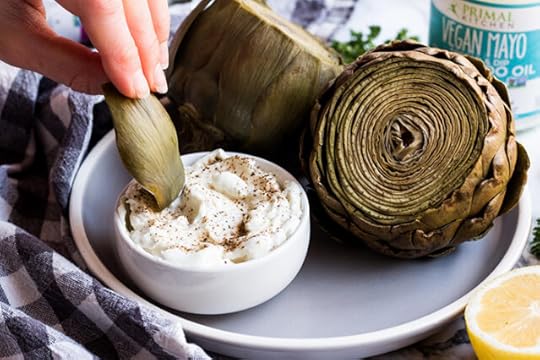 Artichokes are a mysterious vegetable, and a lot of people are intimidated by them. How do you cook an artichoke? How do you cut into it? What parts do you eat? And how does it taste?
Artichokes are a mysterious vegetable, and a lot of people are intimidated by them. How do you cook an artichoke? How do you cut into it? What parts do you eat? And how does it taste?
You may have had marinated artichoke hearts that come in a jar, or you’ve noticed little strips of artichoke in your spinach dip. But eating a whole artichoke is a lot different than having prepared hearts.
In this article, I’m going to show you how to prepare and eat an artichoke, along with my favorite dipping sauces.
Are Artichokes Good For You?
Coming in at 6g of net carbs per whole artichoke, it’s something you’ll want to add to the rotation if you’re keto. Artichokes are also an antioxidant powerhouse, and they have lots of gut-happy resistant starch.
How to Buy Artichokes
If you’ve never bought whole artichokes before, you might wonder how to choose good ones. Here’s what to look for:
Tight leaves. Your artichoke should look like a giant flower bud. Leaves should not be curling out like a blooming flower.
Heft. Pick up a few, and feel their weight. Heavier artichokes are fresher, and lighter ones are older and perhaps dried out.
Brown streaks on the outside, or not. A little browning on the outside is nothing to be concerned about. Some people say that the ones with brown streaks are sweeter because the frost that caused them brings out the natural sugars.
Once your artichokes are cleaned and steamed properly, the leaves and heart are excellent vehicles for dips.
How to Cook an Artichoke (Steam Method)
Serves: 2-4
Time in the kitchen: 45 minutes, including 35 minutes steaming time

Ingredients
2 artichokes
Primal Kitchen® Mayo with Avocado Oil, or Rosemary and Garlic Vegan Mayo if you cannot tolerate eggs
1 lemon
Fresh cracked black pepper
Directions
To prepare an artichoke, first cut off most of the stem on top, leaving about ¼” of the stem left intact.

Cut off the tough bottom of the artichoke, about 1” worth. Use kitchen scissors to trim the tough prickly ends of the artichoke leaves. Cut a lemon in half and rub the cut side all of the cut end of the artichoke.
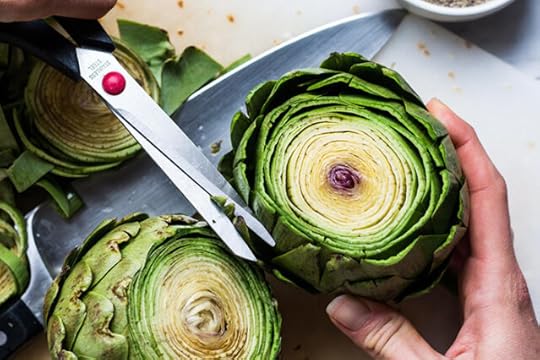
Set up a steamer by filling a pot with some water and a squeeze of lemon. Once the water is boiling, set the heat so the water is at a steady simmer. Set up the steamer basket inside and place the artichokes in the basket cut side down.
Place the lid on and allow the artichokes to steam for around 30 minutes, 35 minutes if they’re quite large. You know they’re finished when you can put a knife through the center of the stem with little resistance.
Allow the artichokes to cool. Combine your favorite Primal Kitchen Mayo with a squeeze of lemon and fresh cracked pepper.
How to Eat an Artichoke
This part is easy. Once your artichoke is cooled, peel the leaves off of one by one, dip in the mayo, and enjoy!

When you’re finished eating the leaves of the artichoke, it’s time to find and clean the heart. Pull off any remaining inner leaves (they’re usually in the shape of a little cone) to expose a fuzzy circle in the stem.
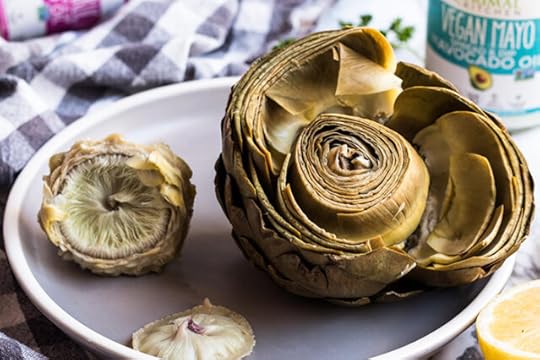
Scoop out those fuzzy pieces out with a spoon and you’ll be left with the artichoke heart, which is the base of the stem and artichoke. Slice it into a few pieces and dip it in the mayo. It’s the most tender, meaty part of the artichoke!
Nutrition Info (per one medium artichoke):
Calories: 60g
Fat: 0g
Total Carbs: 13g
Net Carbs: 6g
Protein: 4g
The post How to Cook and Eat an Artichoke appeared first on Mark's Daily Apple.



Mark Sisson's Blog
- Mark Sisson's profile
- 199 followers











